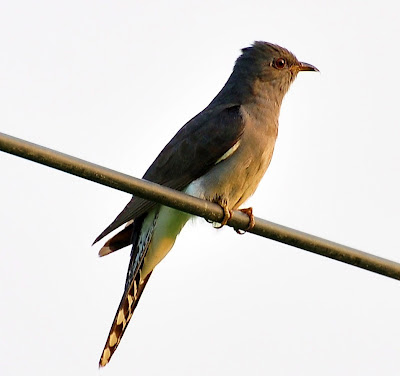Margalla Ridge
It was
going to be another very hot day today so an early start was required to make
the most of this birding opportunity. I was going to try again for Indian Pitta
but having ignored the first alarm I left it too late. I decided that an early
morning drive up onto the Margalla Ridge might be a good idea and so it proved.
However, I was in for a shock when I saw the damage that had been caused by a
fire that had devastated the vegetation. Likely caused by an irresponsibly
discarded cigarette or glass bottle, the fire had destroyed the undergrowth but
it looked as though the Chir Pines had survived probably because the fire would
have passed through so quickly as it engulfed the tinder dry understory. I read
in the newspaper recently about another large part of the Margalla National
Park near to Taxila had also been badly damaged by fire. The monsoon rains will
offer some respite from the threat of further blazes but they don’t appear
imminent.
As I
write this I am watching a juvenile ORIENTAL MAGPIE ROBIN in the garden trying
to find some respite from the sun as it seeks shade under some plants. The
COMMON MYNA have their bills constantly open in an effort to reduce body heat. They
appear glad of the water we have provided. However, back to today’s birding; as
I began my walk the calls of BLUE-THROATED BARBET filled the valley and good
view of one allowed me to admire the beautiful blue colour on the plumage of
the impressive bird. More sombre was a female BROWN-FRONTED WOODPECKER the
presence of which was given away by the gentle tapping on the bark of a tree
and its chak-chak call. It was exciting to see a very much smaller
cousin of the Brown-fronted Woodpecker in the form of a tiny SPECKLED PICULET.
These are hard to see birds that normally hide away in the canopy and are
reportedly represented by a very rare and disjunctive population within
Pakistan. We have been lucky to see them on Trail 5 and in the same area as
today on previous occasions. Winter flocks of Oriental White-eyes and Tit
species often hold one if in an appropriate area.
A
bird that I should have seen before, had I put some more effort into finding
it, became number 304 on my Pakistan list. I was alerted to its presence by its
whistling call and then had really good views of a male GREY-BELLIED CUCKOO. It
is the smallest of the Cuckoo species to visit Pakistan and is a late summer
breeding migrant. It is another bird with a very restricted range in the
country and the Margalla Hills are at its centre. A few minutes later I saw the
male again but I was incredibly lucky and also saw an Hepatic female GREY-BELLIED CUCKOO following the male around the
pines. Clearly his whistling had paid off!
 |
| Grey-bellied Cuckoo Zill Niazi |
I
saw two dove species today; a pair of LAUGHING DOVE and half a dozen SPOTTED
DOVE, the latter mostly on the ground. Their timing is perfect; a pair of
SPOTTED DOVE have just landed in the garden to take a drink. Back to the
Margalla Ridge, overhead a lone HOUSE SWIFT or LITTLE SWIFT, as they are called
elsewhere, flew by. I had two sightings of BLACK-HEADED JAY, one of a single
bird and the second of a pair. A species that can be heard more often than seen
but today they were seemingly less shy. More of a show off the RUFOUS TREEPIE
are easy to spot and two were present.
It is not everyday one sees Pakistan's smallest Parakeet, another species that has an extremely restricted distribution. I have seen a number before but it was still pleasing to see a pair of PLUM-HEADED PARAKEET. The male resplendent with his plum-red head and long blue-green tail.
It is not everyday one sees Pakistan's smallest Parakeet, another species that has an extremely restricted distribution. I have seen a number before but it was still pleasing to see a pair of PLUM-HEADED PARAKEET. The male resplendent with his plum-red head and long blue-green tail.
Being
at an elevation of 3,700 feet above sea level the predominant corvid at this
altitude is the LARGE-BILLED CROW and a pair floated overhead unperturbed by
the BLACK KITE just above them. However, PIED BUSHCHAT seemed as plentiful here
as they are around Islamabad. Here too was a BROWN ROCK CHAT calling from the
top of a pine. As I watched the Brown Rock Chat two female ASIAN PARADISE
FLYCATCHER flew past. I saw a couple of Prinia species this morning; the
insect-like call of the STRIATED PRINIA emanated from several vantage points
around the trail and a couple of GREY-BREASTED PRINIA were also seen today.
As
usual for this location there were plenty of Bulbuls around and all three of
the commoner species in Pakistan were well represented. There were also plenty
of ORIENTAL WHITE-EYE seen and amongst one large group were at least six
GREY-HOODED WARBLER. At the viewpoint not only were there great views of he
city but also a male CRESTED BUNTING that was proclaiming his territory from a
small bush. At that time the PIA flight to Gilgit flew overhead northwards
reminding me that we should have been on it on Friday. Never mind; we might be
third time lucky getting to the Hunza Valley and all of the enigmatic mountain
species it offers.
In
contrast to the pair of grey-form GREAT TIT my attention was drawn to the
stunningly red plumage of a male LONG-TAILED MINIVET that landed nearby. One
could never tire of watching such a beautiful bird. COMMON MYNA was the other
species recorded making this morning’s total a satisfying 28 with one life tick
and worth getting up for!


